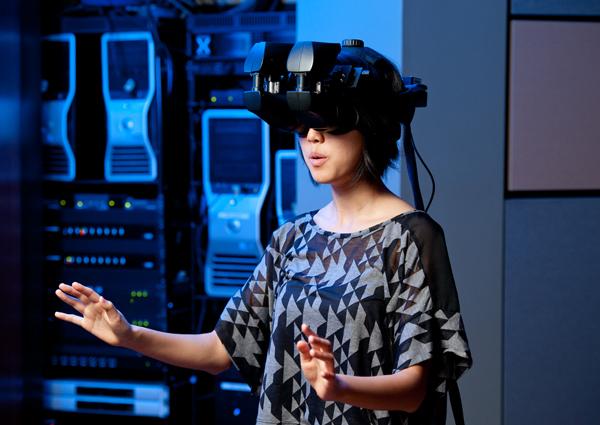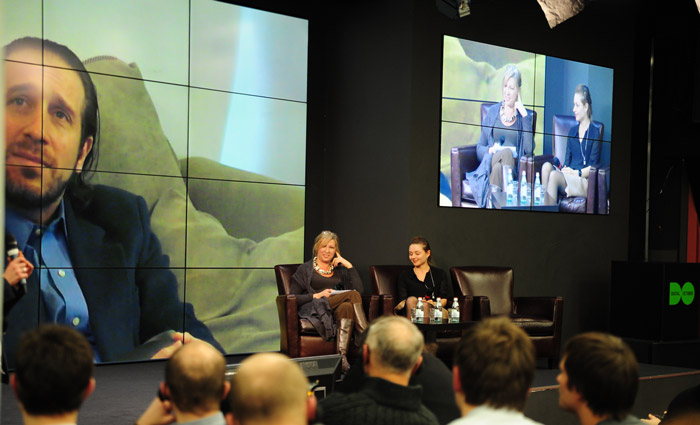Virtual reality: why are enemies always red and you always behind green ones?

Stanford's Virtual Human Interaction Lab
A simple example: on the minimap in the strategy your troops are green, enemy - red. If you look at the opponent's screen, it will be the other way round, it will be green, yours will be red. The color is not fixed, it is only your representation of reality. Even if there are 10 players, everyone will play for the greens.
What about the fact that you will more unconsciously trust your partner in the negotiations if he adds 40% of your face features to your avatar? If it will be for all those present of their same sex and age? Ideal for everyone breathing? Welcome to a world similar to the world of Orwell, but originally from Stanford.
')
Now imagine a lecture in a virtual classroom where 50 students sit. You are lucky, you sit in the most convenient place where the teacher looks at you, where the board can be seen better and everything is generally convenient. It's funny that the other 49 students are in virtuality in the same place - and they see you, for example, somewhere on the edge of the audience. Everyone has their own virtual world, where he gets "all the attention" of the teacher.
Hi, Neo!
Last week, Digital October hosted a lecture by Jeremy Beylenson (professor at the Faculty of Communication at Stanford, a specialist in cognitive psychology) about virtual reality. He talked about the technologies and benefits of the virtual environment - which is quite expected and familiar to most who watched Avatar or Surrogate films - and, more importantly, spoke about what new social aspects will affect such a reality. There are no physical conventions - it means that there is a mass of new opportunities.
To begin with - a few words about the technology of the emergence of "avatars". With the help of photogeometric equipment and corresponding software, models of people and objects are created. These models are loaded into a certain space (technically, the server sends you a complete copy of the “pre-rendered” avatar), and then an analogue of motion capture is used to transfer movements and facial expressions. If you add the presentation of the stereo image in the spectator's glasses - the reality becomes even closer.
Imagine a conference in virtual space. On the one hand, it is very similar to a personal meeting: all the same spontaneous reactions, unconscious movements and many other details that convey the most valuable information at the negotiations. On the other hand, this is virtual reality, and perhaps your negotiating partner has already loaded the optimal behavioral model. Now his computer does not transmit his movements, but something else that corresponds to the strategy. You reply to his proposal - at home he jumps up from his seat, and in virtuality he keeps a calm face.

Here's what else you can do.
- Send different avatars to different conference participants. These can be avatars of the same race as the person you want, of a given age, with given features.
- Send data as if you are looking into the eyes of each participant in the meeting . Beylenson talks about an experiment where two students and a teacher met in virtual reality. Each of the students was convinced that the teacher paid all the attention to him: they did not even notice the “parallelization”. The situation looks real: after all, all movements of the head are read, that is, it is not a “dumbing” that looks exactly in your eyes, but just an attentive interlocutor. And it works even for 1000 people in the audience (taking into account that each student sits in the focus of the teacher) - the results of the experiments speak for themselves, the learning efficiency increases by an average of 10%.
- Psychologists are well aware that the adjustment of gestures, breathing, and so on helps to achieve understanding. A person who “mirrors” your gestures on a subconscious level is perceived as trustworthy. Beylenson suggested simply recording gestures and returning them to the interlocutor in a slightly modified form (in the experiment, after 4-5 seconds). Virtual reality allows this with ease.
- Now imagine an interface for a handshake : a suit or a glove with feedback. It does not cost to write down the information about the handshake of the right person - and the next time to give him this record. It turns out that greeting you, he shakes his hand to himself.
- An avatar can be selected individually for a person . It is important that if you use two images - yours and the interlocutor - and mix them according to the principle of morphing photos in the 40/60 ratio, you will immediately feel confidence and sympathy for the resulting avatar. Beylenson conducted research (he describes it in a lecture), which proved the tremendous effectiveness of this method.
- In the end, no one bothers to “shove” several avatars into one point of space: for example, it may be important for training or sports: you sort of share your body with someone else.
- The features of the avatar leave an imprint on the behavioral model . Roughly speaking, it costs you a long time to be a gray-haired old man - you become calmer. Or you can always be 10 centimeters taller than your interlocutor. Or you can be pretty darn attractive: on tests, this immediately meant a change in the subject's social model.
- Finally - imagine a computer game, where your avatar in the role of the protagonist. At some point, the cut-scene begins - and you can see from your side from your own actions that you have never committed, but still do them right now. From the point of view of psychology - a powerful fixation of attention, a great tool for learning or advertising. And do not even think about contextual advertising sites "18+" :)

Being in any virtual reality, you perform many actions that can be saved more abruptly than the search history:
And when we look at the statistics, I can predict with a high level of probability your race, gender, personality type, your age, your intentions, whether you want to buy something or try to be aggressive. We have demonstrated that people who play virtual games let others know more about themselves than any other person through face-to-face communication, because video games automatically track your behavior. Thus, when we study virtual reality, it is a terrific tool that can be used for various wonderful sentences, of course, also categorization, classification of who you are and what you plan to do.
Links
- Lecture (Russian and English versions);
- Virtual Human Interaction Lab on the English Wiki;
- Proteus effect on the English wiki.
And the last thing: with all this in mind - if suddenly your secretary, colleague and friends in virtual reality turn into Indians with scars across their entire faces, then you should probably look for a mirror. Perhaps the bartender woke the wrong your avatar. If possible, avoid this.
Source: https://habr.com/ru/post/139054/
All Articles